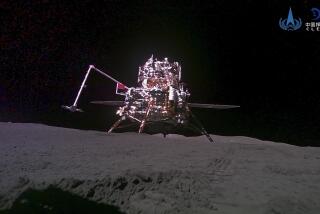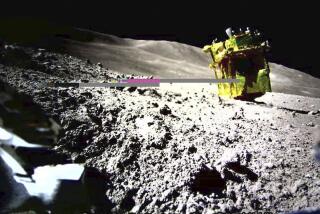GRAIL moon mission ends with a bang
- Share via
After dancing around the moon for months, the twin satellites nicknamed Ebb and Flow performed their final number, crashing into the same peak near the lunar north pole and bringing the GRAIL mission to a close.
A cheer went up in the control room at the Jet Propulsion Laboratory in La Cañada Flintridge as Ebb slammed into the mountain about 2:28 p.m. Monday, followed about half a minute later by Flow. The probes were traveling at nearly 3,800 mph and landed an estimated 25 miles apart.
Even as the team clapped and shook hands in the control room, GRAIL project manager David Lehman acknowledged that the moment was bittersweet.
“Today I brought my handkerchief, just in case,” he said.
The GRAIL mission spacecraft, each the size of a compact washing machine, were launched in September 2011 to study every bump and pothole in the moon’s gravitational field.
“We have essentially collected more than 99.99%” of the data the team had set out to collect, said Massachusetts Institute of Technology geophysicist Maria Zuber, principal investigator for the mission formally known as the Gravity Recovery and Interior Laboratory.
The two NASA spacecraft worked as a team to do so, flying in formation around the moon and logging all the little tugs the gravitational field exerted on their relative speed.
From March to May, Ebb and Flow flew an average of just 30 miles above the lunar surface.
With its primary mission complete, the team upped the ante, lowering the spacecraft so that they surveyed the moon’s bumpy gravitational field from an average of about 15 miles above the surface, Zuber said. Late in the mission, Ebb and Flow came within a mile and a half of prominent features.
The result was the most detailed map ever made of the moon’s gravitational field.
The unprecedented up-close survey revealed a host of findings. The researchers found that the moon’s crust is even thinner than originally thought, and that there are deep fractures in the crust, showing that it may have taken a greater beating from asteroids and comets than planetary scientists had believed. Those results were reported this month in the journal Science.
With the wealth of complex data from the primary mission already available and more from the extended mission to follow in about six months, scientists will be able to dig deeper into the data to see what it reveals about the moon’s core, Zuber said.
The extended mission came with one drawback: Flying so low required more hands-on navigation to maneuver the spacecraft over ridges and keep them from crashing into basins. All that steering required mission scientists to burn fuel some three times per week, causing Ebb and Flow to run out of gas much sooner.
Even so, the mission scientists tried to squeeze every last bit of information out of the spacecraft: Less than an hour before impact time, the engineers burned up the last bits of fuel so that they could measure how much had been left in the tank and use that information to better design future missions.
And although Ebb and Flow landed in the dark, scientists hope that the Lunar Reconnaissance Orbiter will be able to fly over the spot in the coming days and weeks and snap images of the landing site. Examining the impact craters with its suite of instruments could help scientists learn something about the rock just beneath the moon’s surface.
On Monday, NASA announced that the impact sites had been named after the late former astronaut Sally Ride, the first American woman in space. She led Ebb and Flow’s MoonKAM, a camera system that could be used by middle-school students. Ride died of pancreatic cancer in July.







